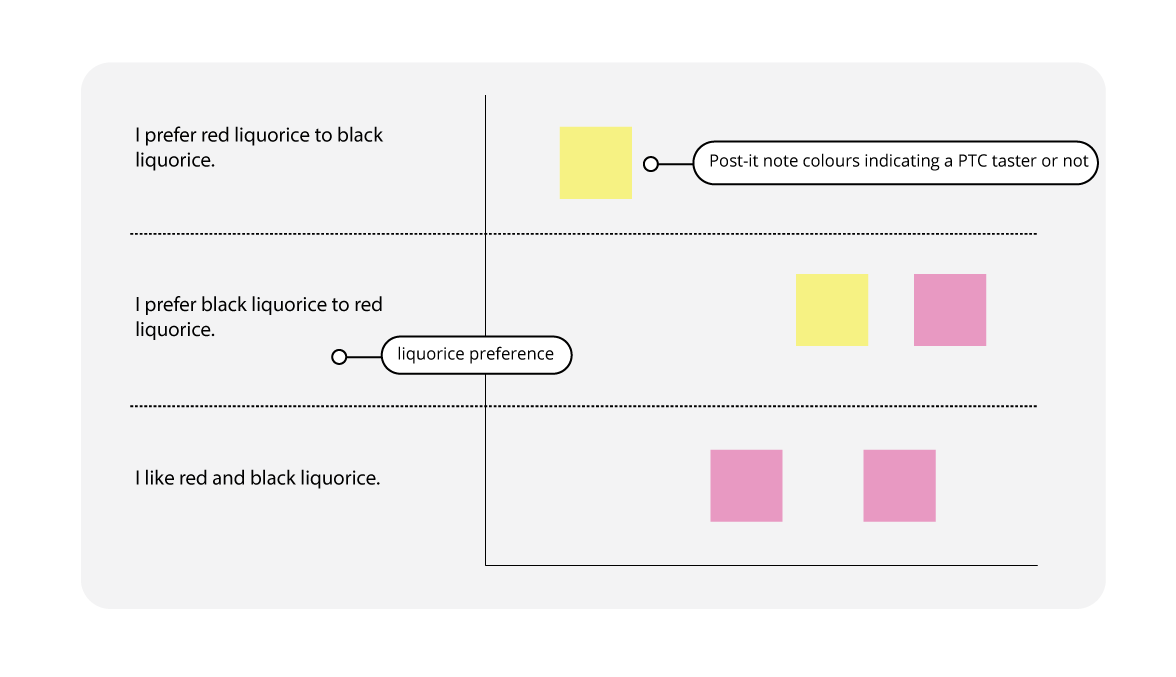Taste Genetics: Food Preferences and PTC Tasting

AUSTRALIAN CURRICULUM ALIGNMENT
- Interpret a range of scientific and media texts, and evaluate models, processes, claims and conclusions by considering the quality of available evidence, including interpreting confidence intervals in secondary data; and use reasoning to construct scientific arguments (ACSBL065)
- Represent data in meaningful and useful ways, including the use of mean, median, range and probability; organise and analyse data to identify trends, patterns and relationships; discuss the ways in which measurement error, instrumental accuracy, the nature of the procedure and the sample size may influence uncertainty and limitations in data; and select, synthesise and use evidence to make and justify conclusions (ACSBL064)
- Conduct investigations, including the use of probabilities to predict inheritance patterns, real or virtual gel electrophoresis, and population simulations to predict population changes, safely, competently and methodically for the collection of valid and reliable data (ACSBL063)
BACKGROUND
Certain foods produce a bitter taste, while others produce a sweet one, and so on. Throughout our evolution, pleasing tastes may have served to signal food that is good for us. Similarly, unpleasant food tastes are believed to inform us that the food is bad. However, this is not always entirely accurate, especially as new food development have significantly outpaced human evolution. Some evidence suggests that plants have adapted to produce bitter tasting molecules to prevent animals from consuming them. An animal that has experienced ill effects from a toxic plant, is unlikely to attempt to consume it again. Humans likely developed bitter taste perception over our evolution to avoid consuming poisonous plants; which contain toxins that are generally bitter tasting. Natural selection for the ability to distinguish between toxic and nontoxic plants may be partially responsible for the allele frequencies in human genes. Tasting bitterness occurs in two-steps: first a molecule binds to a specific receptor protein on the tongue and secondly, this triggers a neurological signal that is sent from the cell to the brain.
In this practical, students examine taste preferences with regards to liquorice, and investigate any possible correlations between liquorice taste preferences and PTC tasting genes. It is worth noting that while relationship between PTC tasting and preferences for broccoli and coffee has been studied, no studies regarding preference for liquorice have been done. This practical, guides students through a comparison of two data-sets, and uses includes an introduction into the pairwise combination test. This in an excellent opportunity for students to connect PTC taste testing to real foods and begin exploring the role genetics play in taste preferences.
METHOD - STUDENT ACTIVITY
PTC Tasting
- Place the control paper strip on your tongue and let it remain there for a few minutes.
- Note any taste or sensation you perceive before removing the paper.
- Take a sip of water to remove the taste.
Liquorice Tasting
- Taste a piece of red liquorice and hold it in your mouth for a few seconds, chew slowly, and swallow.
- Take a small sip of water to clear your mouth of the taste.
- Taste a piece of black liquorice and hold the liquorice in your mouth for a few seconds, chew slowly, and swallow.
Data Collection
- Indicate how bitter the red liquorice tasted on a scale of 1-9 (1= not at all bitter, 9= extremely bitter).
- Record how well you liked the taste by assigning a hedonic score to the red liquorice (1= extremely dislikes taste, 9= extremely likes taste).
- Indicate how bitter the black liquorice tasted (1=not at all bitter, 9=extremely bitter).
- Record how well you liked the taste by assigning a hedonic score to black liquorice (1= extremely dislikes, taste 9= extremely likes taste).
- Pick one of the following statements which applies to you the most: A. I prefer red liquorice to black liquorice. B. I prefer black liquorice to red liquorice. C. I like red and black liquorice equally. This is a pairwise combination test. These tests are characterised by asking individuals to indicate a preferred food when given two different foods to choose from. It is often used by nutrition to understand individual food preferences.
- Graph your liquorice preference on the class post-it graph. Place a yellow post-it note on the graph if they are a PTC taster, or a pink post-it note if they cannot taste PTC. The graph will be divided by your liquorice preferences.
- Following this, study the graph to determine whether the data provides evidence for a relation between PTC tasting and liquorice preference.
OBSERVATION AND RESULTS
Some students will find the PTC testing papers extremely bitter while others will experience a milder taste, or none at all. For strong PTC tasters, the reaction to the test will be immediate and intense. You may or may not observe a correlation between PTC tasting and Liquorice preference within your class population. There is not yet any conclusive scientific evidence to suggest a correlation does exist.
INVESTIGATION
Class discussion:
- Based on the results, ask students if they believe there is sufficient evidence to suggest a correlation between PTC tasting gene and preference for black liquorice with or without sugar.
- For inconclusive results, encourage students to generate ideas for how the experiment may be changed to improve its significance.
- In class discussion, ask students to identify other bitter tasting food alternatives for that could be used for the experiment.
 Time Requirements
Time Requirements
- 45 mins
 Material List
Material List
- PTC Papers (100 strips)
-
Red and Black liquorice
- Drinking water
- Sugar
- Cups
- Post-it notes
 Safety Requirements
Safety Requirements
- Wear appropriate personal protective equipment (PPE).
- Know and follow all regulatory guidelines for the disposal of laboratory wastes.
- Ensure you are aware of any food allergies or special requirements.
- PTC is safe when consumed in small amounts; do not exceed recommended amounts.
- Wash your hands thoroughly before and after the practical.
